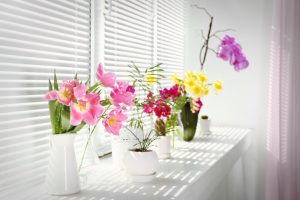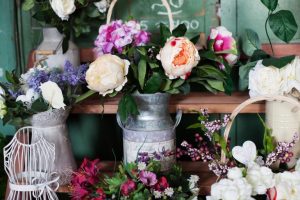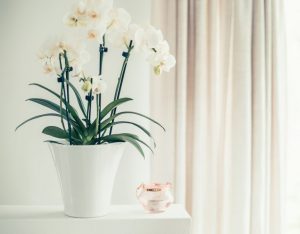4 Flowering Houseplants for your Home

Let’s discover some great flowering houseplants which are simply perfect for your home. As we’ve seen before, they can bring a lot of different health benefits.
Plants increase the amount of oxygen in the room (allowing you to breathe cleaner air), increase the humidity in the air, make your home smell great, and may even absorb some types of radiation… These are just some of the advantages that having houseplants can bring to you and your home.
Flowering houseplants bring you a feeling of health and well-being, and caring for them can even help to reduce stress. This is especially important nowadays, when you think about the busy, hectic lives we lead.
What’s more, you can also use them to decorate – vertical gardens, under the stairs, on windowsills… There are so many ways to use them. All you need to do is adapt them to your space.
Next, we’ll take a look at four species of flowering houseplant that you could buy for your home.

1. Kalanchoe
There are many different subspecies of kalanchoe, and they are generally very easy to grow. Their leaves, which they use to store water, are thick and fleshy. This means you don’t need to water them often, not even during the warmest months of the year. You should let the soil dry completely between watering.
As for the best place to keep this plant, it’s important to put them somewhere where they can get plenty of sunlight. Kalanchoe plants can withstand direct sunlight, but not in excessive amounts, as they can burn. It also needs a minimum temperature of around 41°F to survive.
Because its flowers come in a variety of different colors (pink, red, yellow, white, and orange) you could even create a little corner just for them. This would look perfect in a multicolored home.
2. Anthurium
There are somewhere between 600 and 800 different subspecies of anthurium. In general, they are deciduous plant with beautiful ornamental leaves.
It’s essential to make sure that their soil is always damp, not soaking, as this could cause the partial or total loss of leaves. It’s therefore important that the atmosphere in general is at least partially humid. You might also want to spray them with water from time to time.
Although it’s best to keep anthurium plants somewhere where they can get lots of light, they shouldn’t be exposed to direct sunlight. Like kalanchoe, they also cannot withstand excessively low temperatures.
3. Orchids
There are anywhere between 25,000 and 30,000 different species in the orchid family. Their morphology is very diverse, whether you look at the size of the plant, the size of the flowers, or their scent.
To water them, it’s best to fill a dish of water and place it under the flower pot. However, you mustn’t forget to remove it afterwards – otherwise, the roots will rot. If possible, try to make sure the humidity is at approximately 70%.
Orchids also cannot withstand direct sunlight. However, it is important to keep them somewhere with plenty of light. These are fairly delicate plants, which won’t survive in temperatures below 59°F, or over 72-73°F.
If you look after them properly, they will flower several times a year. Their flowers are very delicate, elegant and ornamental, and are a great way to decorate your house.

4. Peace lily
Peace lilies are instantly recognizable, thanks to their bright green, medium-sized leaves and their white flowers. What’s more, they flower all year round, so they’ll instantly bring a natural feel to your home.
It’s important to make sure that their soil is always damp, except in winter, when you you should let the uppermost levels of soil dry out. To increase humidity, you can spray them periodically with water.
As with the other flowering houseplants we’ve looked at today, they need plenty of light, without being exposed to direct sunlight. As for their ideal temperature, peace lilies grow best in temperatures between 59°F and 68°F.
Decorating your home with flowering houseplants
As we’ve already mentioned in some of our other articles, flowering houseplants can bring enormous health benefits. Plus, you can also use them to decorate, to give your home a more natural feel and fill it with their beautiful, natural perfume.
We’ve given you a few of our favorites, but you might also want to consider some other species, like tropical houseplants.
Let’s discover some great flowering houseplants which are simply perfect for your home. As we’ve seen before, they can bring a lot of different health benefits.
Plants increase the amount of oxygen in the room (allowing you to breathe cleaner air), increase the humidity in the air, make your home smell great, and may even absorb some types of radiation… These are just some of the advantages that having houseplants can bring to you and your home.
Flowering houseplants bring you a feeling of health and well-being, and caring for them can even help to reduce stress. This is especially important nowadays, when you think about the busy, hectic lives we lead.
What’s more, you can also use them to decorate – vertical gardens, under the stairs, on windowsills… There are so many ways to use them. All you need to do is adapt them to your space.
Next, we’ll take a look at four species of flowering houseplant that you could buy for your home.

1. Kalanchoe
There are many different subspecies of kalanchoe, and they are generally very easy to grow. Their leaves, which they use to store water, are thick and fleshy. This means you don’t need to water them often, not even during the warmest months of the year. You should let the soil dry completely between watering.
As for the best place to keep this plant, it’s important to put them somewhere where they can get plenty of sunlight. Kalanchoe plants can withstand direct sunlight, but not in excessive amounts, as they can burn. It also needs a minimum temperature of around 41°F to survive.
Because its flowers come in a variety of different colors (pink, red, yellow, white, and orange) you could even create a little corner just for them. This would look perfect in a multicolored home.
2. Anthurium
There are somewhere between 600 and 800 different subspecies of anthurium. In general, they are deciduous plant with beautiful ornamental leaves.
It’s essential to make sure that their soil is always damp, not soaking, as this could cause the partial or total loss of leaves. It’s therefore important that the atmosphere in general is at least partially humid. You might also want to spray them with water from time to time.
Although it’s best to keep anthurium plants somewhere where they can get lots of light, they shouldn’t be exposed to direct sunlight. Like kalanchoe, they also cannot withstand excessively low temperatures.
3. Orchids
There are anywhere between 25,000 and 30,000 different species in the orchid family. Their morphology is very diverse, whether you look at the size of the plant, the size of the flowers, or their scent.
To water them, it’s best to fill a dish of water and place it under the flower pot. However, you mustn’t forget to remove it afterwards – otherwise, the roots will rot. If possible, try to make sure the humidity is at approximately 70%.
Orchids also cannot withstand direct sunlight. However, it is important to keep them somewhere with plenty of light. These are fairly delicate plants, which won’t survive in temperatures below 59°F, or over 72-73°F.
If you look after them properly, they will flower several times a year. Their flowers are very delicate, elegant and ornamental, and are a great way to decorate your house.

4. Peace lily
Peace lilies are instantly recognizable, thanks to their bright green, medium-sized leaves and their white flowers. What’s more, they flower all year round, so they’ll instantly bring a natural feel to your home.
It’s important to make sure that their soil is always damp, except in winter, when you you should let the uppermost levels of soil dry out. To increase humidity, you can spray them periodically with water.
As with the other flowering houseplants we’ve looked at today, they need plenty of light, without being exposed to direct sunlight. As for their ideal temperature, peace lilies grow best in temperatures between 59°F and 68°F.
Decorating your home with flowering houseplants
As we’ve already mentioned in some of our other articles, flowering houseplants can bring enormous health benefits. Plus, you can also use them to decorate, to give your home a more natural feel and fill it with their beautiful, natural perfume.
We’ve given you a few of our favorites, but you might also want to consider some other species, like tropical houseplants.
All cited sources were thoroughly reviewed by our team to ensure their quality, reliability, currency, and validity. The bibliography of this article was considered reliable and of academic or scientific accuracy.







